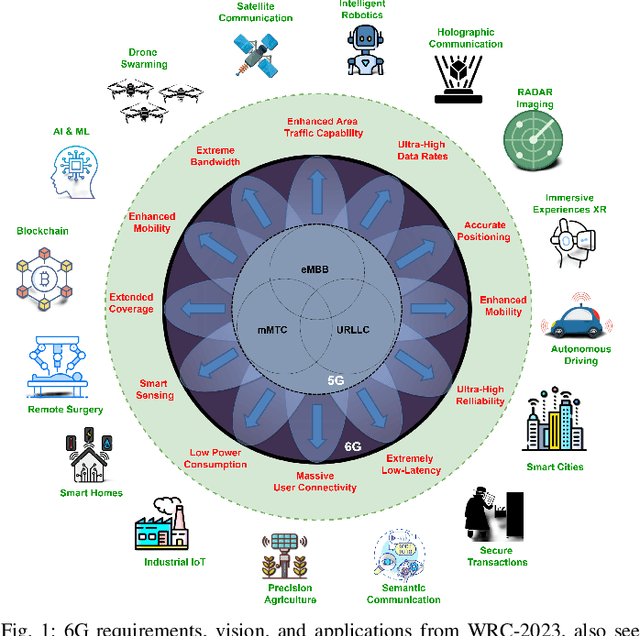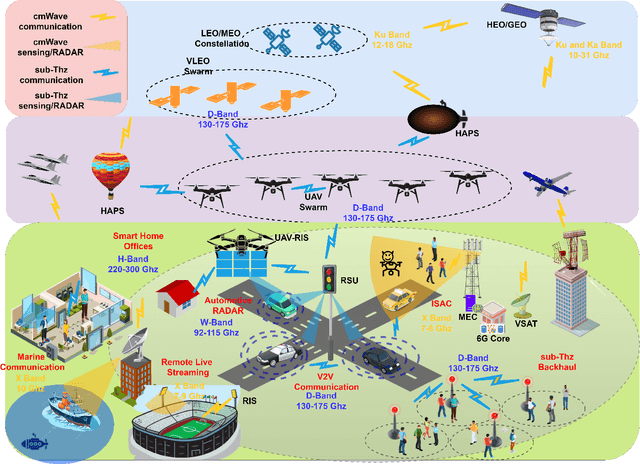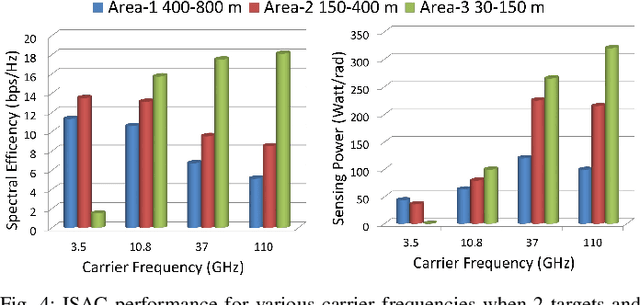Theodore S. Rappaport
Site-Specific Location Calibration and Validation of Ray-Tracing Simulator NYURay at Upper Mid-Band Frequencies
Jul 29, 2025Abstract:Ray-tracing (RT) simulators are essential for wireless digital twins, enabling accurate site-specific radio channel prediction for next-generation wireless systems. Yet, RT simulation accuracy is often limited by insufficient measurement data and a lack of systematic validation. This paper presents site-specific location calibration and validation of NYURay, NYU's in-house ray tracer, at upper mid-band frequencies (6.75 GHz and 16.95 GHz). We propose a location calibration algorithm that corrects GPS-induced position errors by optimizing transmitter-receiver (TX-RX) locations to align simulated and measured power delay profiles, improving TX-RX location accuracy by 42.3% for line-of-sight (LOS) and 13.5% for non-line-of-sight (NLOS) scenarios. Validation across 18 TX-RX locations shows excellent RT accuracy in path loss prediction, with path loss exponent (PLE) deviations under 0.14. While RT underestimates delay spread and angular spreads, their cumulative distributions remain statistically similar. The validated NYURay advances RT validation and provides reliable channel statistics for 6G deployment.
Statistical and Deterministic RCS Characterization for ISAC Channel Modeling
Feb 17, 2025Abstract:In this study, we perform a statistical analysis of the radar cross section (RCS) for various test targets in an indoor factory at \(25\)-\(28\) GHz, with the goal of formulating parameters that may be used for target identification and other sensing applications for future wireless systems. The analysis is conducted based on measurements in monostatic and bistatic configurations for bistatic angles of \(20^\circ\), \(40^\circ\), and \(60^\circ\), which are functions of transmitter-receiver (T-R) and target positions, via accurate \(3\)dB beamwidth of \(10^\circ\) in both azimuth and elevation planes. The test targets include unmanned aerial vehicles, an autonomous mobile robot, and a robotic arm. We utilize parametric statistical distributions to fit the measured RCS data. The analysis reveals that the \textit{lognormal and gamma distributions} are effective in modeling the RCS of the test targets over different reflecting points of the target itself, i.e. when target is in motion. Additionally, we provide a framework for evaluating the deterministic bistatic RCS of a rectangular sheet of laminated wood, due to its widespread use in indoor hotspot environments. Novel deterministic and statistical RCS models are evaluated, incorporating dependencies on the bistatic angle, T-R distance (\(2\)m -\(10\)m) and the target. The results demonstrate that some proposed RCS models accurately fit the measured data, highlighting their applicability in bistatic configurations.
Upper Mid-Band Channel Measurements and Characterization at 6.75 GHz FR1(C) and 16.95 GHz FR3 in an Indoor Factory Scenario
Nov 06, 2024



Abstract:This paper presents detailed radio propagation measurements for an indoor factory (InF) environment at 6.75 GHz and 16.95 GHz using a 1 GHz bandwidth channel sounder. Conducted at the NYU MakerSpace in the NYU Tandon School of Engineering campus in Brooklyn, NY, USA, our measurement campaign characterizes a representative small factory with diverse machinery and open workspaces across 12 locations, comprising 5 line-of-sight (LOS) and 7 non-line-of-sight (NLOS) scenarios. Analysis using the close-in (CI) path loss model with a 1 m reference distance reveals path loss exponents (PLE) below 2 in LOS at 6.75 GHz and 16.95 GHz, while in NLOS PLE is similar to free-space propagation. The RMS delay spread (DS) decreases at higher frequencies with a clear frequency dependence. Similarly, RMS angular spread (AS) measurements show wider spreads in NLOS compared to LOS at both frequency bands, with a decreasing trend as frequency increases. These observations in a dense-scatterer environment demonstrate frequency-dependent behavior that deviate from existing industry-standard models. Our findings provide crucial insights into complex propagation mechanisms in factory environments, essential for designing robust industrial wireless networks at upper mid-band frequencies.
Urban Outdoor Propagation Measurements and Channel Models at 6.75 GHz FR1(C) and 16.95 GHz FR3 Upper Mid-Band Spectrum for 5G and 6G
Oct 24, 2024Abstract:Global allocations in the upper mid-band spectrum (4-24 GHz) necessitate a comprehensive exploration of the propagation behavior to meet the promise of coverage and capacity. This paper presents an extensive Urban Microcell (UMi) outdoor propagation measurement campaign at 6.75 GHz and 16.95 GHz conducted in Downtown Brooklyn, USA, using a 1 GHz bandwidth sliding correlation channel sounder over 40-880 m propagation distance, encompassing 6 Line of Sight (LOS) and 14 Non-Line of Sight (NLOS) locations. Analysis of the path loss (PL) reveals lower directional and omnidirectional PL exponents compared to mmWave and sub-THz frequencies in the UMi environment, using the close-in PL model with a 1 m reference distance. Additionally, a decreasing trend in root mean square (RMS) delay spread (DS) and angular spread (AS) with increasing frequency was observed. The NLOS RMS DS and RMS AS mean values are obtained consistently lower compared to 3GPP model predictions. Point data for all measured statistics at each TX-RX location are provided to supplement the models and results. The spatio-temporal statistics evaluated here offer valuable insights for the design of next-generation wireless systems and networks.
Point Data for Site-Specific Mid-band Radio Propagation Channel Statistics in the Indoor Hotspot (InH) Environment for 3GPP and Next Generation Alliance (NGA) Channel Modeling
Sep 30, 2024

Abstract:Extensive work has been carried out in the past year by various organizations in an effort to determine standardized statistical channel impulse response (CIR) parameters for the newly-released mid-band spectrum (7.25 GHz -- 24.25 GHz) [1]--[5]. In this work, we show that the wireless community currently lacks a unified method for presenting key parameters required for transparency and utilization by several constituencies when presenting propagation data for use by standard bodies or third parties to create statistical CIR models. This paper aims to solve the existing problem by offering a standard method for providing key propagation parameters such as bandwidth, antenna beamwidth, noise-threshold level, and coarseness in point form, for use in creating standards or comparing parameters, rather than providing commonly-used cumulative distribution function (CDF) plots, which hide the observed key statistics on a location-by-location, point-by-point basis. The method for presenting propagation data, proposed here, may be used for statistical channel modeling of pooled datasets from many contributors, additionally also holding promise for exploring ray-tracing (e.g. site-specific) channel modeling. The indoor hotspot (InH) data collected in Spring2024 at 6.75 GHz and 16.95 GHZ by NYU WIRELESS [1]--[3] is provided for the first time in point form, to augment statistical models previously presented solely as CDFs, to demonstrate how a standardized approach to measurement data could allow others to utilize the site-specific locations and key channel parameters observed at each location, to better understand, vet, and build upon statistical or site-specific CIRs from the contributions of many different data sources.
Angular Spread Statistics for 6.75 GHz FR1(C) and 16.95 GHz FR3 Mid-Band Frequencies in an Indoor Hotspot Environment
Sep 04, 2024Abstract:We present detailed multipath propagation spatial statistics for next-generation wireless systems operating at lower and upper mid-band frequencies spanning 6--24 GHz. The large-scale spatial characteristics of the wireless channel include Azimuth angular Spread of Departure (ASD) and Zenith angular Spread of Departure (ZSD) of multipath components (MPC) from a transmitter and the Azimuth angular Spread of Arrival (ASA) and Zenith angular Spread of Arrival (ZSA) at a receiver. The angular statistics calculated from measurements were compared with industry-standard 3GPP models, and ASD and ASA values were found to be in close agreement at both 6.75 GHz and 16.95 GHz. Measured LOS ASD was found larger than 3GPP ASD indicating more diverse MPC departure directions in the azimuth. ZSA and ZSD were observed smaller than the 3GPP modeling results as most multipath arrivals and departures during measurements were recorded at the boresight antenna elevation. The wide angular spreads indicate a multipath-rich spatial propagation at 6.75 GHz and 16.95 GHz, showing greater promise for the implementation of MIMO beamforming systems in the mid-band spectrum.
CmWave and Sub-THz: Key Radio Enablers and Complementary Spectrum for 6G
Jun 26, 2024



Abstract:Sixth-generation (6G) networks are poised to revolutionize communication by exploring alternative spectrum options, aiming to capitalize on strengths while mitigating limitations in current fifth-generation (5G) spectrum. This paper explores the potential opportunities and emerging trends for cmWave and sub-THz spectra as key radio enablers. This paper poses and answers three key questions regarding motivation of additional spectrum to explore the strategic implementation and benefits of cmWave and sub-THz spectra. Also, we show using case studies how these complementary spectrum bands will enable new applications in 6G, such as integrated sensing and communication (ISAC), re-configurable intelligent surfaces (RIS) and non-terrestrial networks (NTN). Numerical simulations reveal that the ISAC performance of cmWave and sub-THz spectra outperforms that of existing 5G spectrum, including sub-6 GHz and mmWave. Additionally, we illustrate the effective interplay between RIS and NTN to counteract the effects of high attenuation at sub-THz frequencies. Finally, ongoing standardization endeavors, challenges and promising directions are elucidated for these complementary spectrum bands.
Waste Factor and Waste Figure: A Unified Theory for Modeling and Analyzing Wasted Power in Radio Access Networks for Improved Sustainability
May 13, 2024



Abstract:This paper introduces Waste Factor (W), also denoted as Waste Figure (WF) in dB, a promising new metric for quantifying energy efficiency in a wide range of circuits and systems applications, including data centers and RANs. Also, the networks used to connect data centers and AI computing engines with users for ML applications must become more power efficient. This paper illustrates the limitations of existing energy efficiency metrics that inadequately capture the intricate energy dynamics of RAN components. We delineate the methodology for applying W across various network configurations, including MISO, SIMO, and MIMO systems, and demonstrate the effectiveness of W in identifying energy optimization opportunities. Our findings reveal that W not only offers nuanced insights into the energy performance of RANs but also facilitates informed decision-making for network design and operational efficiency. Furthermore, we show how W can be integrated with other KPIs to guide the development of optimal strategies for enhancing network energy efficiency under different operational conditions. Additionally, we present simulation results for a distributed multi-user MIMO system at 3.5, 17, and 28 GHz, demonstrating overall network power efficiency on a per square kilometer basis, and show how overall W decreases with an increasing number of base stations and increasing carrier frequency. This paper shows that adopting W as a figure of merit can significantly contribute to the sustainability and energy optimization of next-generation wireless communication networks, paving the way for greener and more sustainable, energy-efficient 5G and 6G technologies.
Wideband Penetration Loss through Building Materials and Partitions at 6.75 GHz in FR1(C) and 16.95 GHz in the FR3 Upper Mid-band spectrum
May 02, 2024



Abstract:The 4--8 GHz FR1(C) and 7--24 GHz upper mid-band FR3 spectrum are promising new 6G spectrum allocations being considered by the International Telecommunications Union (ITU) and major governments around the world. There is an urgent need to understand the propagation behavior and radio coverage, outage, and material penetration for the global mobile wireless industry in both indoor and outdoor environments in these emerging frequency bands. This work presents measurements and models that describe the penetration loss in co-polarized and cross-polarized antenna configurations, exhibited by common materials found inside buildings and on building perimeters, including concrete, low-emissivity glass, wood, doors, drywall, and whiteboard at 6.75 GHz and 16.95 GHz. Measurement results show consistent lower penetration loss at 6.75 GHz compared to 16.95 GHz for all ten materials measured for co and cross-polarized antennas at incidence. For instance, the low-emissivity glass wall presents 33.7 dB loss at 6.75 GHz, while presenting 42.3 dB loss at 16.95 GHz. Penetration loss at these frequencies is contrasted with measurements at sub-6 GHz, mmWave and sub-THz frequencies along with 3GPP material penetration loss models. The results provide critical knowledge for future 5G and 6G cellular system deployments as well as refinements for the 3GPP material penetration models.
Using Waste Factor to Optimize Energy Efficiency in Multiple-Input Single-Output (MISO) and Multiple-Input Multiple-Output (MIMO) Systems
May 02, 2024



Abstract:This paper introduces Waste Factor (W) and Waste Figure (WF) to assess power efficiency in any multiple-input multiple-output (MIMO) or single-input multiple-output (SIMO) or multiple-input single-output (MISO) cascaded communication system. This paper builds upon the new theory of Waste Factor, which systematically models added wasted power in any cascade for parallel systems such as MISO, SIMO, and MIMO systems, which are prevalent in current wireless networks. Here, we also show the advantage of W compared to conventional metrics for quantifying and analyzing energy efficiency. This work explores the utility of W in assessing energy efficiency in communication channels, within Radio Access Networks (RANs).
 Add to Chrome
Add to Chrome Add to Firefox
Add to Firefox Add to Edge
Add to Edge